14 Ways To Take Your Tuna Casserole To The Next Level

Tuna casserole became a staple of American households in the early- to mid-20th century. Thanks to canned tuna and condensed soups, it was economical and simple to prepare, and could easily fill the bellies of an entire family. Today, it may be considered somewhat old fashioned and kitschy, but like other traditional American casseroles, it's a solid base comfort food recipe that invites all kinds of flavor and texture experimentation to elevate it.
The most basic recipe for tuna casserole includes pasta, typically egg noodles, canned tuna, and a cream sauce that binds it all together. The sauce can be made using canned soups or crafted from scratch, such as a bechamel or mornay sauce. Peas are traditionally added to give it a vegetable component. Any one of these essential elements -- pasta, tuna, sauce, vegetable -- can be swapped out, upgraded, or experimented with to take your tuna casserole to the next level. Here are 14 creative ways to upgrade this classic dish.
Read more: 12 Underrated Types Of Fish You Should Try At Least Once
Splurge On High-Quality, Gourmet Canned Tuna
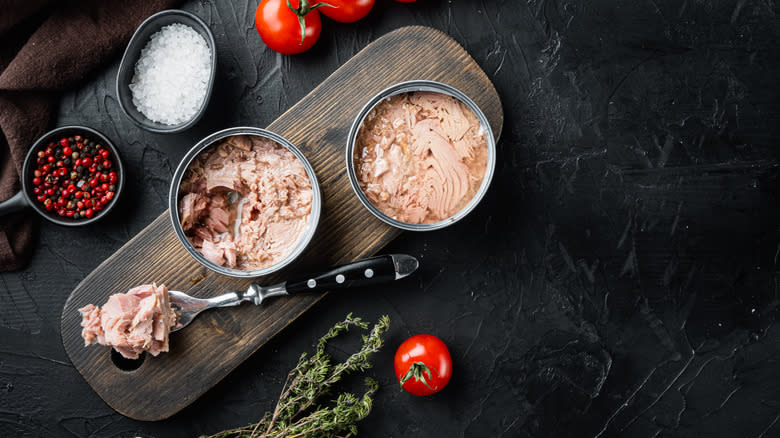
The sheer variety of canned tuna on grocery store shelves can make your head spin. Countless brands, some packed in water, some in oil, light or white, solid or chunk. What does all of that mean, anyway? You can take a tuna information deep dive, but here are the basics.
White tuna is albacore, while light tuna can be several other species, typically yellowfin or skipjack. Albacore tends to have a milder flavor, while the others will taste more overtly fishy. Whether it's packed in oil or water affects its flavor, and also it's nutrition: Oil-packed means there are more calories and fat, but also more flavor. Tuna that's labeled "solid" will be in larger pieces than that labeled "chunk." You'll also want to note other factors on the can that refer to sustainability: terms like "pole-and-line caught," "FAD-free," and "school-caught" indicate fishing practices that are the least intrusive to other ocean life.
Now, as for what's the best variety of canned tuna, particularly for casserole, that is going to be subjective. Instead of reaching for the least expensive can on the shelf, take a look at some of the higher-end offerings. Brands like Tonnino, Fishwife, and Ortiz may be pricier than the more familiar brands, but they pack a ton of flavor, and will elevate your casserole to true gourmet status.
Add Other Types Of Canned Seafood
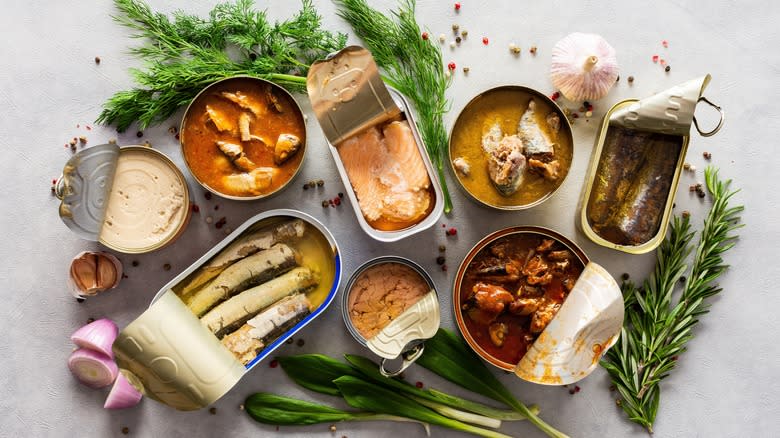
The popularity of tinned fish as a simple, elegant snack continues on social media, at restaurants, and at home (girl dinner, anyone?). While canned seafood is designed to be enjoyed on its own, no preparation required, those tasty morsels can also be added to recipes to provide a punch of powerful flavor. And what better dish to add canned seafood to than one that's built around canned fish? Tuna casserole can become a real seafood celebration with the addition of other kinds of canned, jarred, and tinned fish.
Big, intensely flavorful fish like salmon and mackerel will add extra meatiness and richness to the dish. You can even opt for smoked versions if you want to go for a unique flavor profile with your casserole. Little briny specimens like sardines and anchovies pack a lot of potency in a small package. Canned shellfish like mussels, oysters, shrimp, and crab work nicely as complements to tuna. Combining different fish with the titular tuna is one of the easiest ways to infuse extra texture and flavor to your casserole.
Don't Overcook Your Pasta
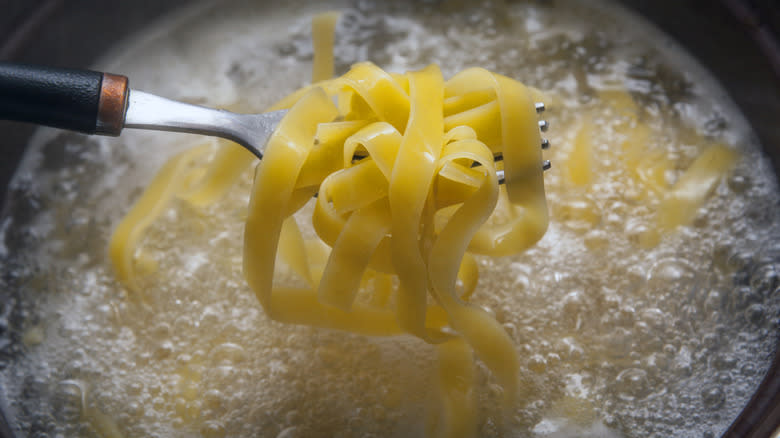
Pasta is essentially the textural base of a tuna noodle casserole, giving the dish its starch and structure; it's imperative to cook it properly. Undercooked noodles will be unpleasantly tough and chewy, and overcooked pasta becomes a mushy mess. Achieving this can be harder than you might think, since you can't really take a test nibble of a noodle while it's baking in the oven like you can when you're boiling it in a pot.
Ideally you want to partially cook your pasta before assembling the casserole, and have it finish cooking in the oven. Depending on the type of noodle you're using, the timing of this process can differ widely. Smaller, thinner pasta shapes may only need a few brief moments in boiling water in order to hydrate and soften their texture before baking. Thicker, larger noodles will need more time. Chef Sara Moulton doesn't pre-cook her casserole noodles at all, and instead simply soaks them in warm water beforehand. It may take some trial and error to find the best timing for your particular pasta, but it's worth the trouble to end up with a perfectly textured casserole.
Use Rice Instead Of Noodles
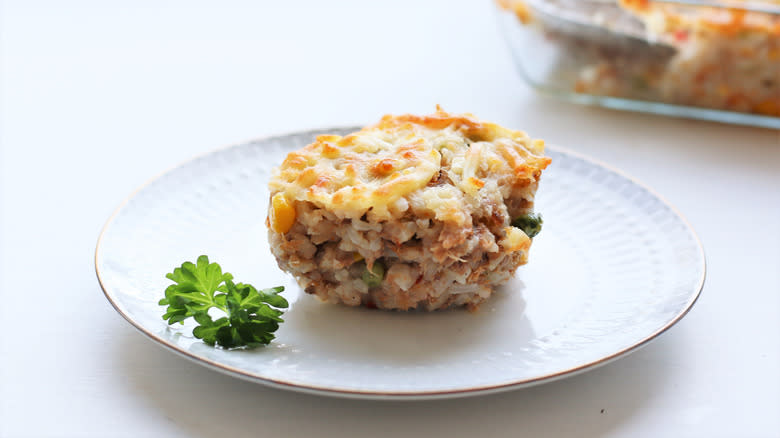
If you're a fan of sushi, you know that fish and rice are a perfect combination, so swapping rice in as the starchy base for tuna noodle casserole just makes sense. Rice provides a different texture than noodles, and the variety of rice out there gives you lots of options to mix things up.
Long grain rice is an excellent choice for casseroles, as it cooks up with a fluffy texture and the grains don't clump together, making the dish seem light and airy. Basmati and Jasmine rice fall under this category, and along with their fitting texture, they're aromatic and flavorful, too. Short and medium grained rice, like sushi and arborio rice, release a lot of starch when cooked and can seem heavy and stodgy in a casserole, so it's best to stick with long-grained varieties. Black, brown, red, and wild rice are good options to consider if you're looking for stronger flavor, while white rice will be mild and fairly neutral in comparison.
Depending on the type of rice and your particular recipe, you may not have to pre-cook it, saving yourself a step. The casserole needs to have enough liquid and the baking time needs to be long enough for the grains to fully cook through. If your recipe calls for a long cooking time, avoid using instant or minute rice, as it's already cooked through and will likely turn to mush as the casserole bakes.
Ditch The Canned Soups And Make Your Own Sauce

Many casserole recipes call for canned condensed soups to be used as the sauce component. This is certainly a convenient option, as they're easy to use and packed with flavor. However, they're typically also packed with salt and preservatives: for example, one serving of Campbell's Cream of Mushroom condensed soup contains 860 milligrams of sodium, which is over ⅓ of the recommended daily intake. There are healthier options -- look for unsalted or low sodium versions if you plan to used canned soups. But why not have complete control over your casserole and make your own sauce from scratch?
Yes, making your own sauce is more labor-intensive than popping open a can, but there are lots of benefits. You can control each ingredient, making sure everything is high quality. You can control the salt level, saving your casserole from becoming a sodium bomb. Bechamel is a simple, classic French cream sauce that works well in a tuna casserole. Mornay is a bechamel with the addition of cheese, and is a popular sauce for tuna casserole in Australia. From these bases, the flavor opportunities are endless: Throw in some pesto, tomato paste, or any herbs and spices you like.
Make It Cheesy
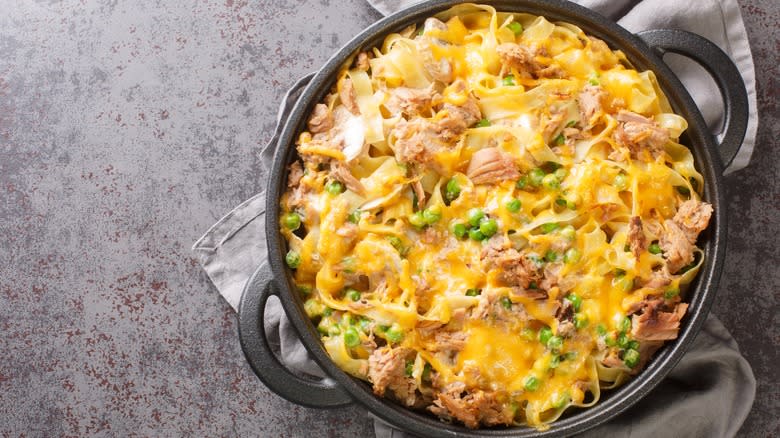
There's an old-fashioned widespread belief that seafood and dairy shouldn't go together. Anyone who's had a delicious tuna melt or luxurious lobster mac and cheese knows this couldn't be further from the truth. Tuna noodle casserole is another arrow that pierces a hole through that myth, with its combination of fish and creamy sauce -- and sometimes cheese.
Not all tuna casserole recipes call for cheese, but it's a welcome addition that adds another layer of fat and flavor. Melty cheeses work well as a topping, such as jack and cheddar. You can go for even more flavor with pepper jack, or smoked cheddar. But there's no need to limit cheese to just the topping. Cheese can be incorporated into the sauce, such as with a mornay. It can also be layered in the casserole, as you would when making a lasagna, to give each bite extra melty cheesiness. Experiment with hard cheese, like romano and parmesan, and softer cheese, like mozzarella, to add varied cheesy texture and flavor.
Throw In Lots Of Seasonal Veggies
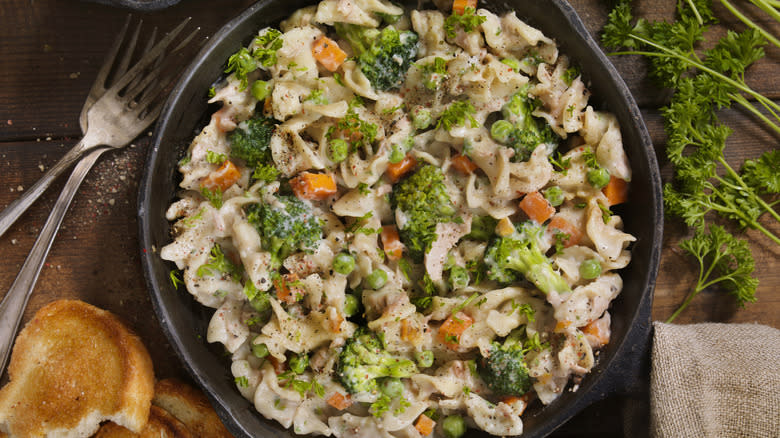
For convenience, frozen vegetables can't be beat. Instead of going through the laborious processes of washing and prepping, just open the bag and they're ready to go. For casseroles, though, using frozen veggies is not the best idea. They release loads of liquid when they cook, which can turn your casserole into a thin and watery mess. For vegetables that really shine in your baked dish, grab whatever is in season and fresh.
A shopping trip at the nearest farmer's market is a great way to find out which veggies are at their peak, or you can take a look at our seasonal produce guide. Just about any vegetable works well in a tuna casserole, as long as it can withstand some time in the oven. Summertime calls for zucchini and corn, while asparagus and artichokes give the dish a light springtime flavor. Winter veggies like Brussels sprouts and broccoli are hearty and fortifying, and fall is a great time for squash and leafy greens like kale and collards. Fresh seasonal vegetables add not just flavor and texture, but colorful nutrition to your casserole.
Make It Surf-And-Turf With Meat

Pescatarians can skip ahead, but for those who eat meat as well as seafood, a great way to upgrade your tuna casserole is by adding some turf to your surf. Tuna is meaty on its own, so it doesn't get outdone by poultry, beef, or pork.
Tuna is known as "chicken of the sea," so it's no surprise that it goes well with chicken. Dark meat is less likely to overcook, but if you prefer white meat, that works too -- it just might end up a bit dry. Keep the chicken chunky if you want a nice meaty texture, or shred it and mix it in for softer, subtler chicken bites. Ground turkey is another good poultry option, or ground beef if you want a heartier flavor. Diced ham, pieces of crispy bacon, and ground pork sausage also work very well in a casserole. Make sure to pre-cook the meat before assembling the casserole.
Don't Skimp On Seasonings
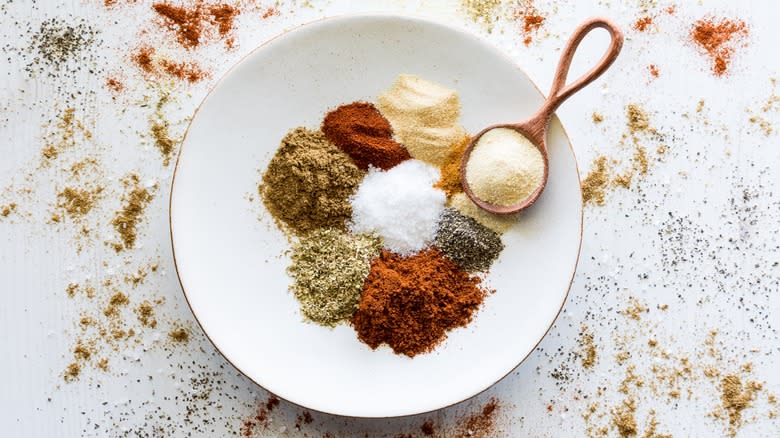
A tuna casserole is loaded with carbs and cream, which means if it's not seasoned properly, it can be a bland and boring, heavy and cloying dish. The easiest way to ensure this is not the case is to start with salt. Properly salting each element of the casserole enhances every flavor, so make sure that you're adding enough to the pasta water, sauce, veggies, and tuna. Each element should be salted on its own, so that when they're mixed together, everything is in balance, guaranteeing that every bite is perfectly seasoned.
Salt and a little bit of freshly cracked pepper is all you really need, but if you want to go for more flavor, look to your spice rack. Mustard powder makes a tangy addition to tuna casserole, brightening up the heavy elements of the dish and complementing the fish's natural flavor. Dried herbs like dill, parsley, and chives shine with seafood, as do spice mixes like Old Bay and Cajun seasoning.
Amplify Flavor With Fish Sauce
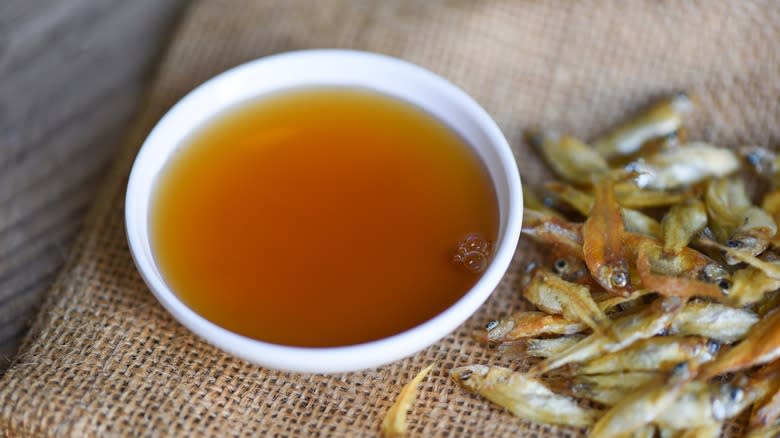
Fish sauce is the secret ingredient that can take just about any dish to another level. Common in Asian and Mediterranean cuisines, this powerhouse of flavor is made from fish that's salted and fermented. During the process, the fish release liquid, which is bottled after the solids are filtered out. The resulting sauce is briny, deeply savory, and packed full of umami. It can be a little bit funky, but used in small doses, it adds depth and intensifies flavor like no other ingredient.
In tuna noodle casserole, a touch of fish sauce amplifies the tuna flavor, while providing a savory undertone that contrasts with the creamy rich sauce. You don't want to overdo it or the fish sauce can take over everything else, so start with a few drops in your sauce add more to taste. Keep in mind that fish sauce is salty, so you may need to adjust your seasoning.
Heat Things Up With Chiles

Because of its over-the-top creaminess and opulent richness, tuna casserole can sometimes come across as heavy and one-note. If you find your dish is lacking some pep, you can make it pop by turning up the heat. There are numerous ways to add piquancy to your casserole, depending on the level and style of heat you're looking for.
Fresh chiles can be minced and tossed into the mix for a zippy vegetal heat, whether you like mild jalapenos or searingly hot serranos. Dried and powdered chile can meld easily into the casserole's sauce, giving it a spicy dimension to contrast with its creaminess -- opt for cayenne if you want it super hot, ancho powder or paprika if you like to keep things mellow. For a subtle tinge of chile heat, add whole chiles, fresh or dried, to the sauce as it's simmering, then remove them before adding the sauce to the dish.
Get Fresh With Herbs

Rich dishes like tuna casserole need an element of brightness to make them truly sing. One way to do that is to add fresh herbs. They can be added to the casserole mix itself, or sprinkled on top as a garnish -- or both if you want an intensely herbaceous casserole.
Tough, woody herbs like rosemary and thyme can be baked into the casserole, as they retain their flavor and texture during cooking. Lemon thyme makes a particularly fitting partner for tuna with its aromatic, citrusy flavor. Leafy herbs like basil, cilantro, and parsley add a wonderful pop of green color and vibrant aromas when chopped and added to the top of the casserole after cooking -- same with delicate herbs such as dill and chives. You don't want to add them too early, as heat will cause them to lose their potency. Branching out to add other, less commonly used herbs in your casserole can be a fun way to bring out unique flavors.
Don't Forget To Add Acidity
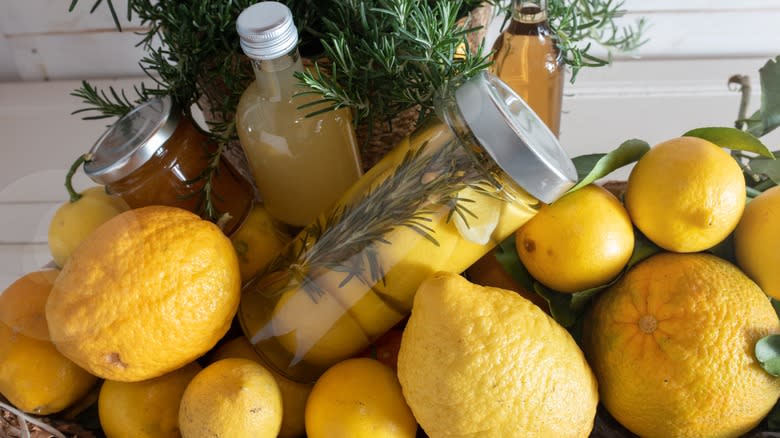
Imagine this scenario: You taste your tuna casserole; it's properly seasoned, everything's cooked right, but something is missing that you can't quite put your finger on. More than likely, the culprit is a lack of acidity. Acidity is what gives food its zing and zip, and without it, flavors fall flat. None of the common major ingredients in tuna casserole are particularly acidic, so it's important to add it in some form to balance the richness and give the dish pizzazz.
Lemon juice and vinegar are kitchen staples that can be utilized for this purpose, although caution must be used when combining acidity with dairy, as too much can cause it to curdle. Just a splash or two, though, added to the casserole will brighten up every flavor it touches. If you want acidity without the flavor that comes along with lemon or vinegar, try powdered citric acid instead.
Certain vegetables contain high amounts of acidity and make great additions to tuna casserole. Tomatoes and tomatillos (technically fruit, but used more like vegetables) bring a vibrant tanginess to the dish. Any pickled vegetable is going to bring plenty of acid to the table, like pickled peppers or brined olives. Whatever form it takes, that burst of acidity is going to elevate your tuna casserole to another level.
Read the original article on The Daily Meal.


